International Finance Assignment: Derivatives and Swaps
VerifiedAdded on 2023/01/17
|6
|1131
|85
Homework Assignment
AI Summary
This document provides comprehensive solutions to an international finance assignment. It begins by evaluating the technical analysis and Balance of Payments (BOP) approaches to forecasting exchange rates, highlighting their strengths and limitations. The assignment then assesses credit risk and repricing interest rate risk, explaining their impact on investments. Further, it compares and contrasts foreign currency futures and currency options, detailing their characteristics and trading strategies. Finally, the assignment analyzes and proposes the major differences between interest rate swaps and currency swaps, covering their structures, applications, and risk profiles. Overall, this assignment offers a detailed exploration of core concepts in international finance, providing valuable insights into forecasting, risk management, and derivative instruments.
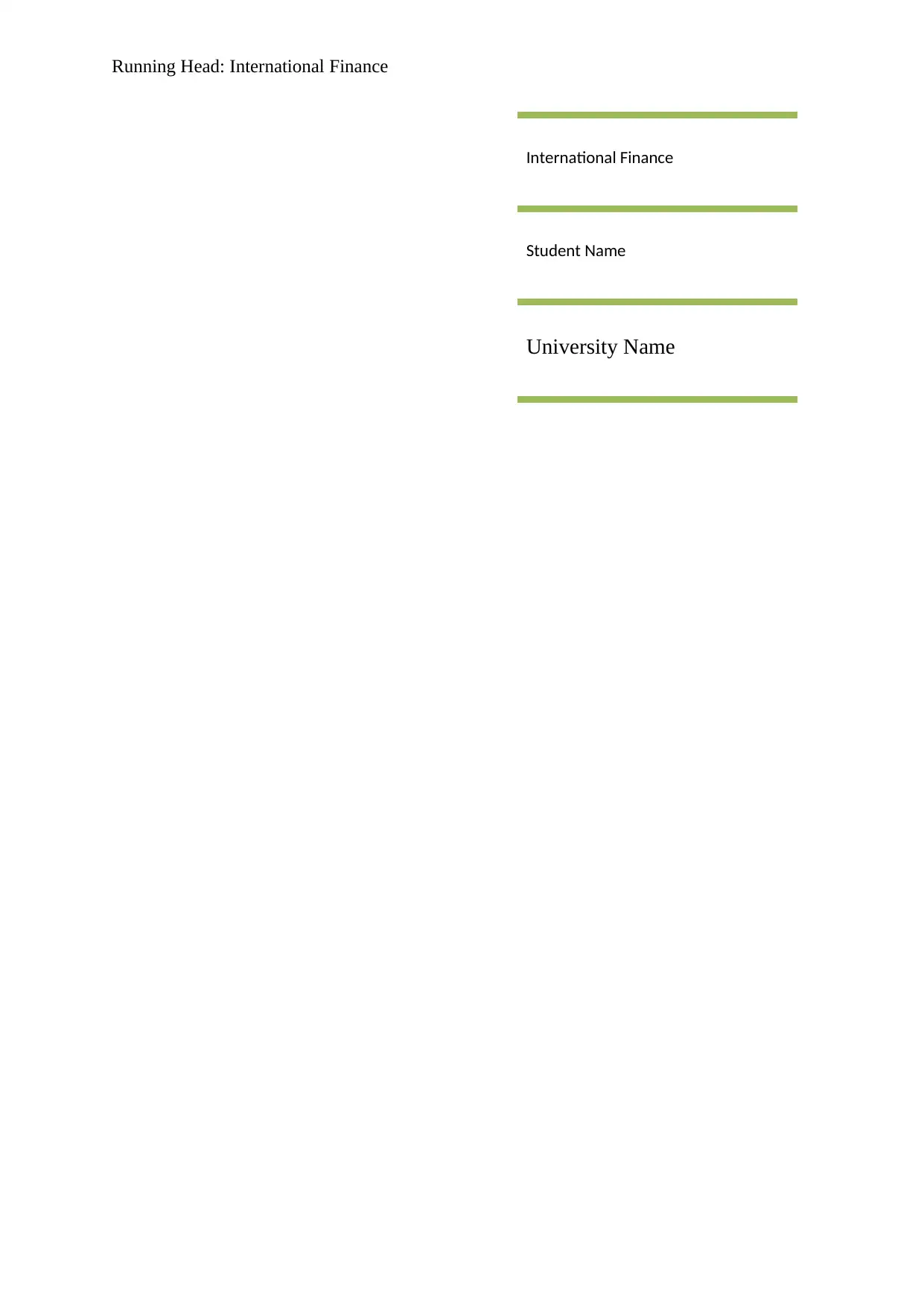
Running Head: International Finance
International Finance
Student Name
University Name
International Finance
Student Name
University Name
Paraphrase This Document
Need a fresh take? Get an instant paraphrase of this document with our AI Paraphraser
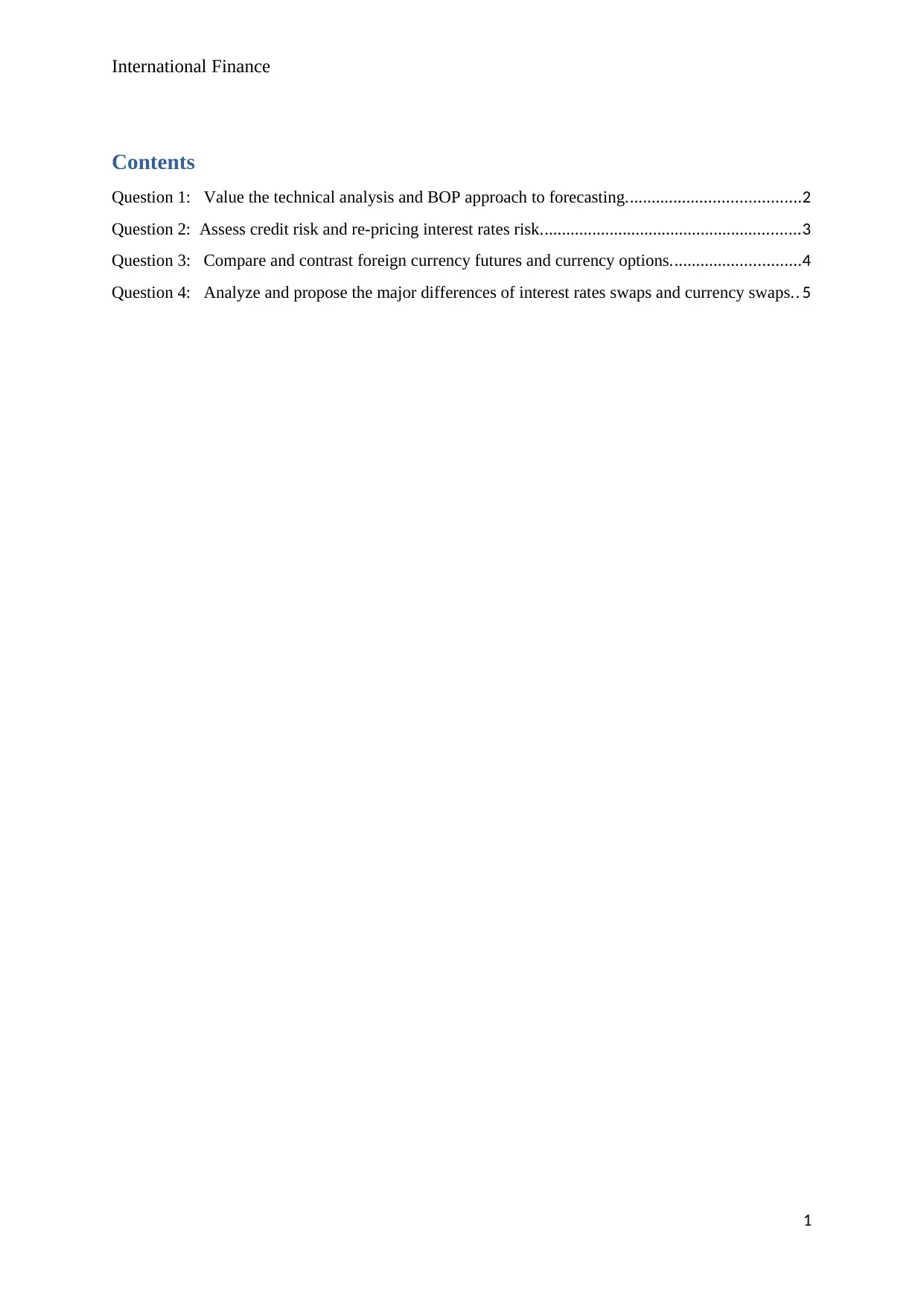
International Finance
Contents
Question 1: Value the technical analysis and BOP approach to forecasting........................................2
Question 2: Assess credit risk and re-pricing interest rates risk............................................................3
Question 3: Compare and contrast foreign currency futures and currency options..............................4
Question 4: Analyze and propose the major differences of interest rates swaps and currency swaps.. 5
1
Contents
Question 1: Value the technical analysis and BOP approach to forecasting........................................2
Question 2: Assess credit risk and re-pricing interest rates risk............................................................3
Question 3: Compare and contrast foreign currency futures and currency options..............................4
Question 4: Analyze and propose the major differences of interest rates swaps and currency swaps.. 5
1
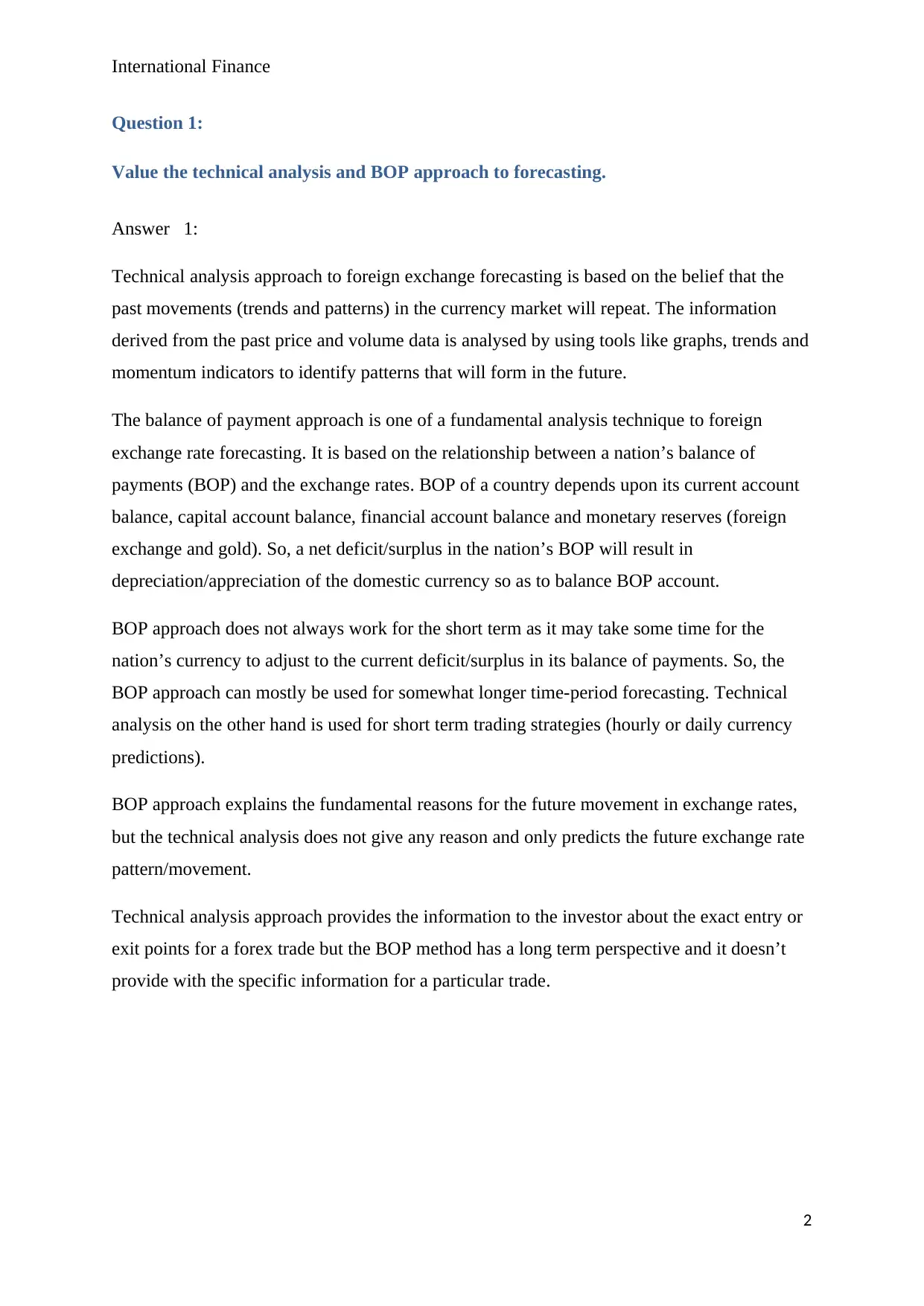
International Finance
Question 1:
Value the technical analysis and BOP approach to forecasting.
Answer 1:
Technical analysis approach to foreign exchange forecasting is based on the belief that the
past movements (trends and patterns) in the currency market will repeat. The information
derived from the past price and volume data is analysed by using tools like graphs, trends and
momentum indicators to identify patterns that will form in the future.
The balance of payment approach is one of a fundamental analysis technique to foreign
exchange rate forecasting. It is based on the relationship between a nation’s balance of
payments (BOP) and the exchange rates. BOP of a country depends upon its current account
balance, capital account balance, financial account balance and monetary reserves (foreign
exchange and gold). So, a net deficit/surplus in the nation’s BOP will result in
depreciation/appreciation of the domestic currency so as to balance BOP account.
BOP approach does not always work for the short term as it may take some time for the
nation’s currency to adjust to the current deficit/surplus in its balance of payments. So, the
BOP approach can mostly be used for somewhat longer time-period forecasting. Technical
analysis on the other hand is used for short term trading strategies (hourly or daily currency
predictions).
BOP approach explains the fundamental reasons for the future movement in exchange rates,
but the technical analysis does not give any reason and only predicts the future exchange rate
pattern/movement.
Technical analysis approach provides the information to the investor about the exact entry or
exit points for a forex trade but the BOP method has a long term perspective and it doesn’t
provide with the specific information for a particular trade.
2
Question 1:
Value the technical analysis and BOP approach to forecasting.
Answer 1:
Technical analysis approach to foreign exchange forecasting is based on the belief that the
past movements (trends and patterns) in the currency market will repeat. The information
derived from the past price and volume data is analysed by using tools like graphs, trends and
momentum indicators to identify patterns that will form in the future.
The balance of payment approach is one of a fundamental analysis technique to foreign
exchange rate forecasting. It is based on the relationship between a nation’s balance of
payments (BOP) and the exchange rates. BOP of a country depends upon its current account
balance, capital account balance, financial account balance and monetary reserves (foreign
exchange and gold). So, a net deficit/surplus in the nation’s BOP will result in
depreciation/appreciation of the domestic currency so as to balance BOP account.
BOP approach does not always work for the short term as it may take some time for the
nation’s currency to adjust to the current deficit/surplus in its balance of payments. So, the
BOP approach can mostly be used for somewhat longer time-period forecasting. Technical
analysis on the other hand is used for short term trading strategies (hourly or daily currency
predictions).
BOP approach explains the fundamental reasons for the future movement in exchange rates,
but the technical analysis does not give any reason and only predicts the future exchange rate
pattern/movement.
Technical analysis approach provides the information to the investor about the exact entry or
exit points for a forex trade but the BOP method has a long term perspective and it doesn’t
provide with the specific information for a particular trade.
2
⊘ This is a preview!⊘
Do you want full access?
Subscribe today to unlock all pages.

Trusted by 1+ million students worldwide
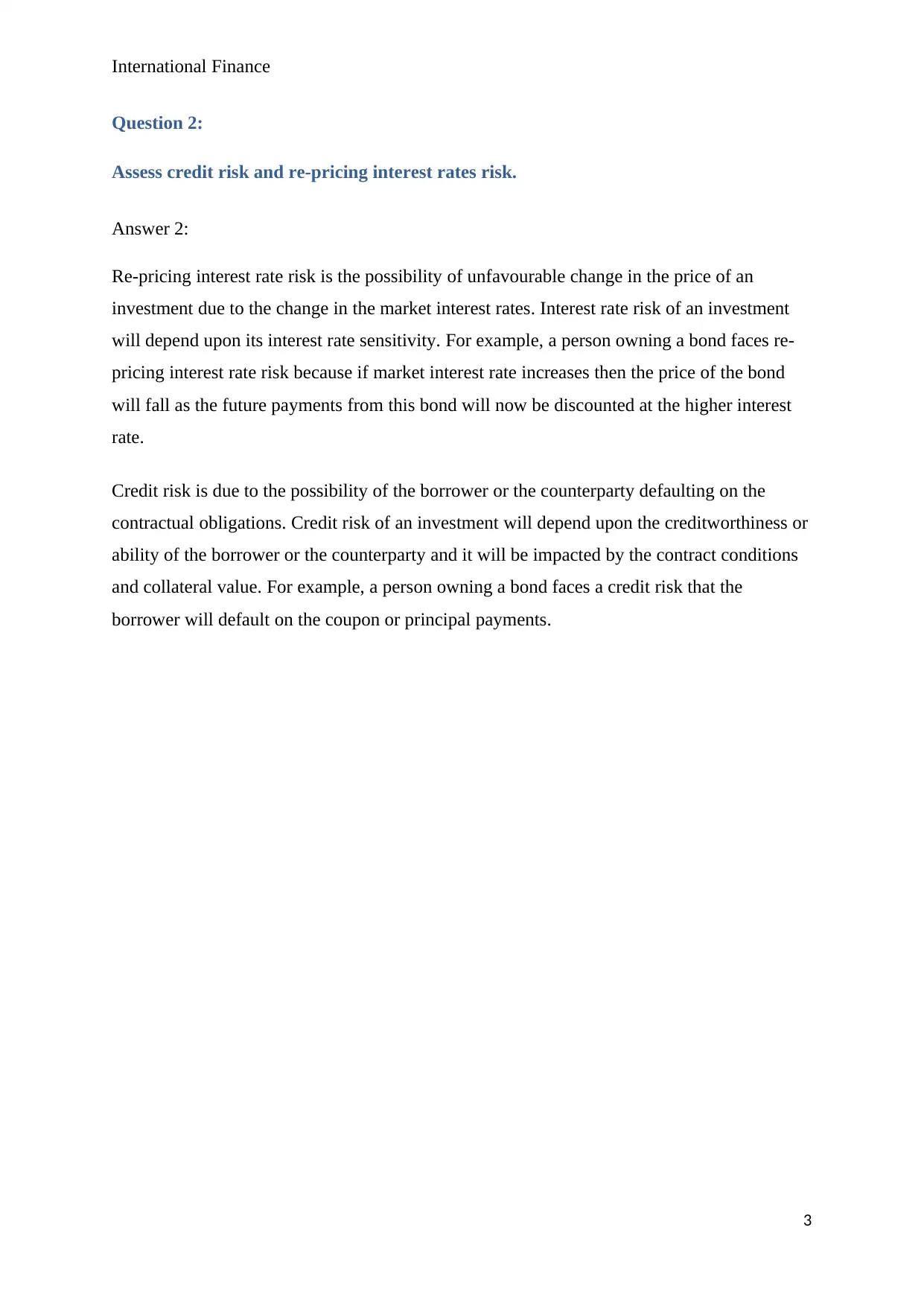
International Finance
Question 2:
Assess credit risk and re-pricing interest rates risk.
Answer 2:
Re-pricing interest rate risk is the possibility of unfavourable change in the price of an
investment due to the change in the market interest rates. Interest rate risk of an investment
will depend upon its interest rate sensitivity. For example, a person owning a bond faces re-
pricing interest rate risk because if market interest rate increases then the price of the bond
will fall as the future payments from this bond will now be discounted at the higher interest
rate.
Credit risk is due to the possibility of the borrower or the counterparty defaulting on the
contractual obligations. Credit risk of an investment will depend upon the creditworthiness or
ability of the borrower or the counterparty and it will be impacted by the contract conditions
and collateral value. For example, a person owning a bond faces a credit risk that the
borrower will default on the coupon or principal payments.
3
Question 2:
Assess credit risk and re-pricing interest rates risk.
Answer 2:
Re-pricing interest rate risk is the possibility of unfavourable change in the price of an
investment due to the change in the market interest rates. Interest rate risk of an investment
will depend upon its interest rate sensitivity. For example, a person owning a bond faces re-
pricing interest rate risk because if market interest rate increases then the price of the bond
will fall as the future payments from this bond will now be discounted at the higher interest
rate.
Credit risk is due to the possibility of the borrower or the counterparty defaulting on the
contractual obligations. Credit risk of an investment will depend upon the creditworthiness or
ability of the borrower or the counterparty and it will be impacted by the contract conditions
and collateral value. For example, a person owning a bond faces a credit risk that the
borrower will default on the coupon or principal payments.
3
Paraphrase This Document
Need a fresh take? Get an instant paraphrase of this document with our AI Paraphraser
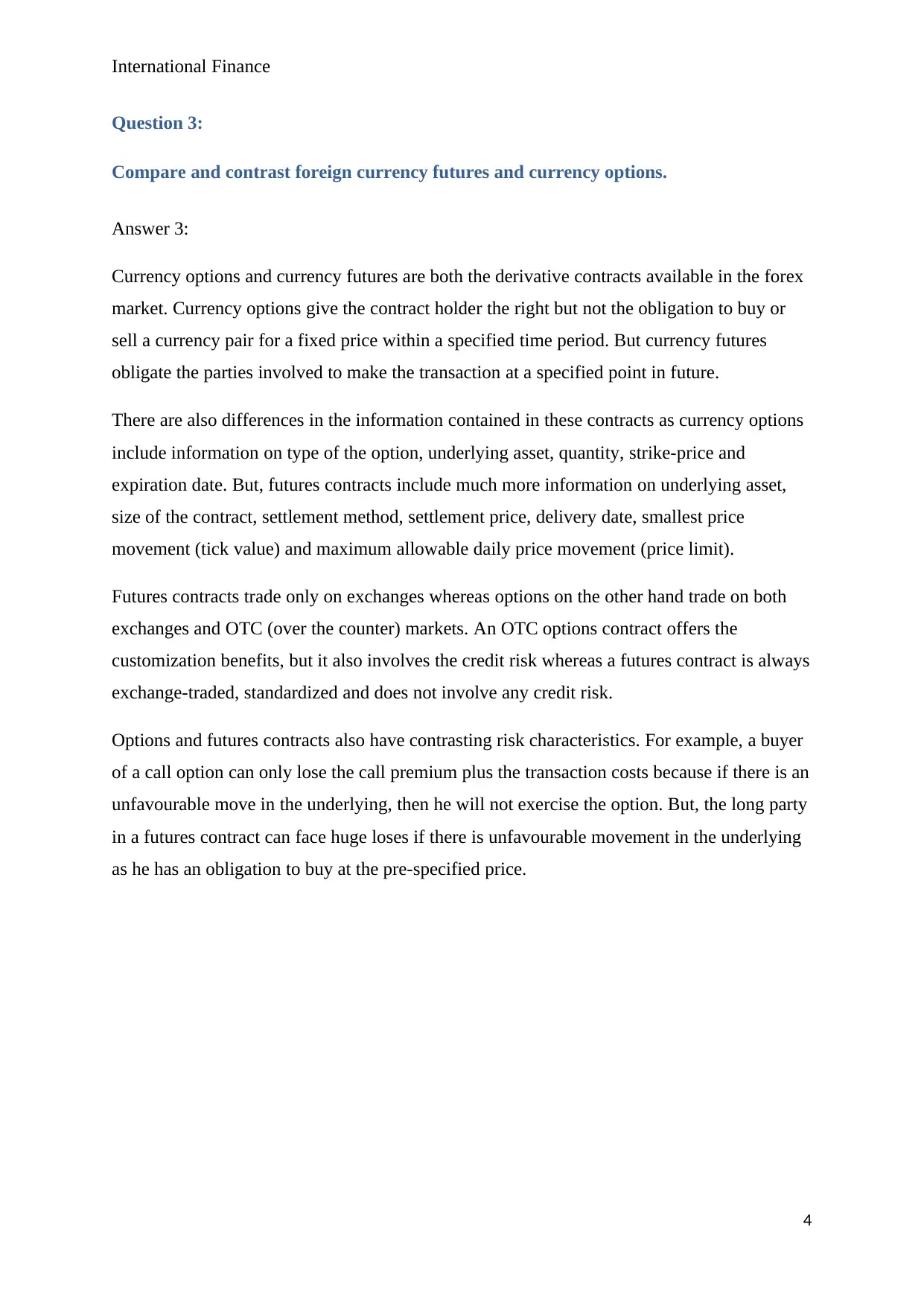
International Finance
Question 3:
Compare and contrast foreign currency futures and currency options.
Answer 3:
Currency options and currency futures are both the derivative contracts available in the forex
market. Currency options give the contract holder the right but not the obligation to buy or
sell a currency pair for a fixed price within a specified time period. But currency futures
obligate the parties involved to make the transaction at a specified point in future.
There are also differences in the information contained in these contracts as currency options
include information on type of the option, underlying asset, quantity, strike-price and
expiration date. But, futures contracts include much more information on underlying asset,
size of the contract, settlement method, settlement price, delivery date, smallest price
movement (tick value) and maximum allowable daily price movement (price limit).
Futures contracts trade only on exchanges whereas options on the other hand trade on both
exchanges and OTC (over the counter) markets. An OTC options contract offers the
customization benefits, but it also involves the credit risk whereas a futures contract is always
exchange-traded, standardized and does not involve any credit risk.
Options and futures contracts also have contrasting risk characteristics. For example, a buyer
of a call option can only lose the call premium plus the transaction costs because if there is an
unfavourable move in the underlying, then he will not exercise the option. But, the long party
in a futures contract can face huge loses if there is unfavourable movement in the underlying
as he has an obligation to buy at the pre-specified price.
4
Question 3:
Compare and contrast foreign currency futures and currency options.
Answer 3:
Currency options and currency futures are both the derivative contracts available in the forex
market. Currency options give the contract holder the right but not the obligation to buy or
sell a currency pair for a fixed price within a specified time period. But currency futures
obligate the parties involved to make the transaction at a specified point in future.
There are also differences in the information contained in these contracts as currency options
include information on type of the option, underlying asset, quantity, strike-price and
expiration date. But, futures contracts include much more information on underlying asset,
size of the contract, settlement method, settlement price, delivery date, smallest price
movement (tick value) and maximum allowable daily price movement (price limit).
Futures contracts trade only on exchanges whereas options on the other hand trade on both
exchanges and OTC (over the counter) markets. An OTC options contract offers the
customization benefits, but it also involves the credit risk whereas a futures contract is always
exchange-traded, standardized and does not involve any credit risk.
Options and futures contracts also have contrasting risk characteristics. For example, a buyer
of a call option can only lose the call premium plus the transaction costs because if there is an
unfavourable move in the underlying, then he will not exercise the option. But, the long party
in a futures contract can face huge loses if there is unfavourable movement in the underlying
as he has an obligation to buy at the pre-specified price.
4
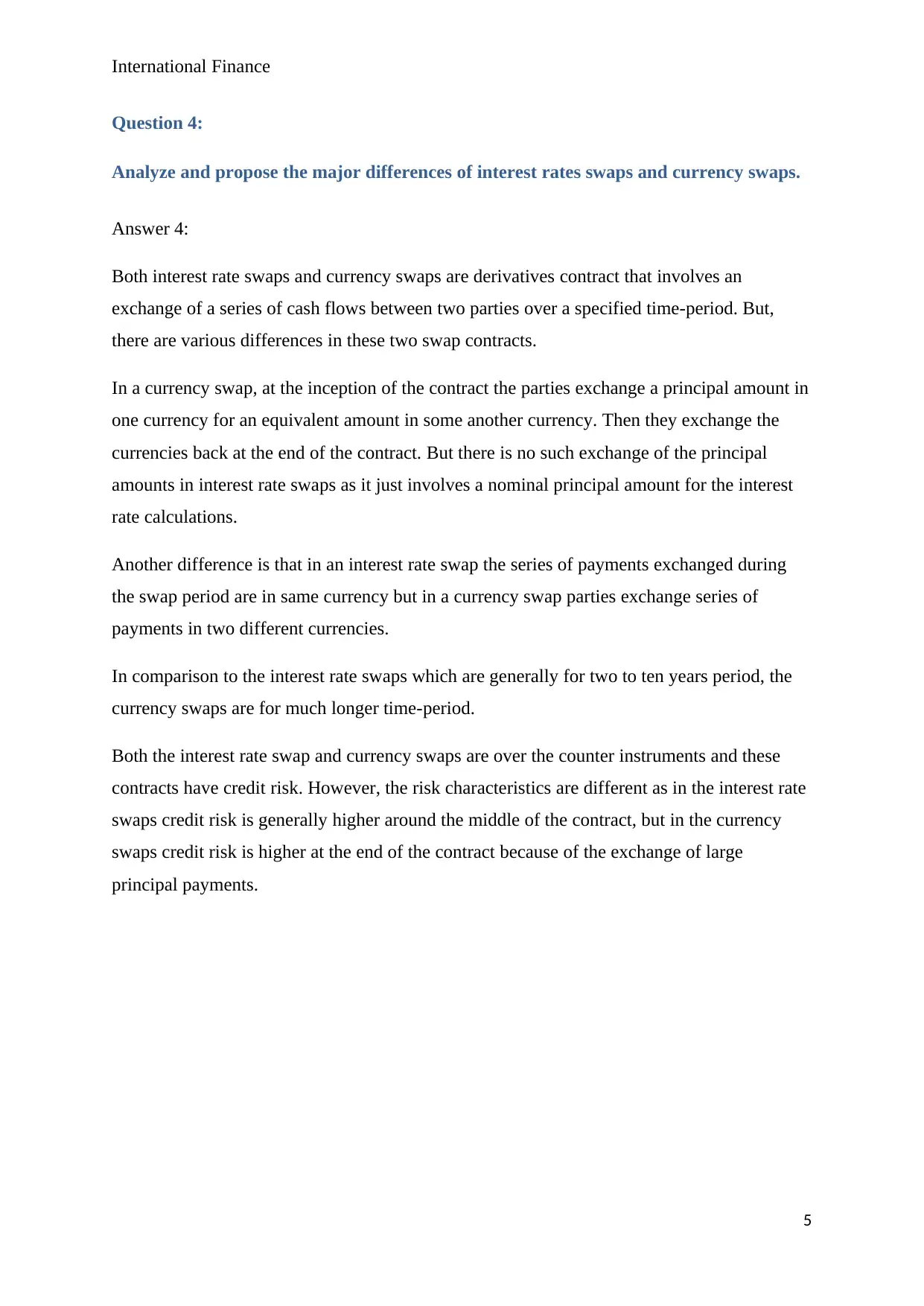
International Finance
Question 4:
Analyze and propose the major differences of interest rates swaps and currency swaps.
Answer 4:
Both interest rate swaps and currency swaps are derivatives contract that involves an
exchange of a series of cash flows between two parties over a specified time-period. But,
there are various differences in these two swap contracts.
In a currency swap, at the inception of the contract the parties exchange a principal amount in
one currency for an equivalent amount in some another currency. Then they exchange the
currencies back at the end of the contract. But there is no such exchange of the principal
amounts in interest rate swaps as it just involves a nominal principal amount for the interest
rate calculations.
Another difference is that in an interest rate swap the series of payments exchanged during
the swap period are in same currency but in a currency swap parties exchange series of
payments in two different currencies.
In comparison to the interest rate swaps which are generally for two to ten years period, the
currency swaps are for much longer time-period.
Both the interest rate swap and currency swaps are over the counter instruments and these
contracts have credit risk. However, the risk characteristics are different as in the interest rate
swaps credit risk is generally higher around the middle of the contract, but in the currency
swaps credit risk is higher at the end of the contract because of the exchange of large
principal payments.
5
Question 4:
Analyze and propose the major differences of interest rates swaps and currency swaps.
Answer 4:
Both interest rate swaps and currency swaps are derivatives contract that involves an
exchange of a series of cash flows between two parties over a specified time-period. But,
there are various differences in these two swap contracts.
In a currency swap, at the inception of the contract the parties exchange a principal amount in
one currency for an equivalent amount in some another currency. Then they exchange the
currencies back at the end of the contract. But there is no such exchange of the principal
amounts in interest rate swaps as it just involves a nominal principal amount for the interest
rate calculations.
Another difference is that in an interest rate swap the series of payments exchanged during
the swap period are in same currency but in a currency swap parties exchange series of
payments in two different currencies.
In comparison to the interest rate swaps which are generally for two to ten years period, the
currency swaps are for much longer time-period.
Both the interest rate swap and currency swaps are over the counter instruments and these
contracts have credit risk. However, the risk characteristics are different as in the interest rate
swaps credit risk is generally higher around the middle of the contract, but in the currency
swaps credit risk is higher at the end of the contract because of the exchange of large
principal payments.
5
⊘ This is a preview!⊘
Do you want full access?
Subscribe today to unlock all pages.

Trusted by 1+ million students worldwide
1 out of 6
Related Documents
Your All-in-One AI-Powered Toolkit for Academic Success.
+13062052269
info@desklib.com
Available 24*7 on WhatsApp / Email
![[object Object]](/_next/static/media/star-bottom.7253800d.svg)
Unlock your academic potential
Copyright © 2020–2025 A2Z Services. All Rights Reserved. Developed and managed by ZUCOL.





